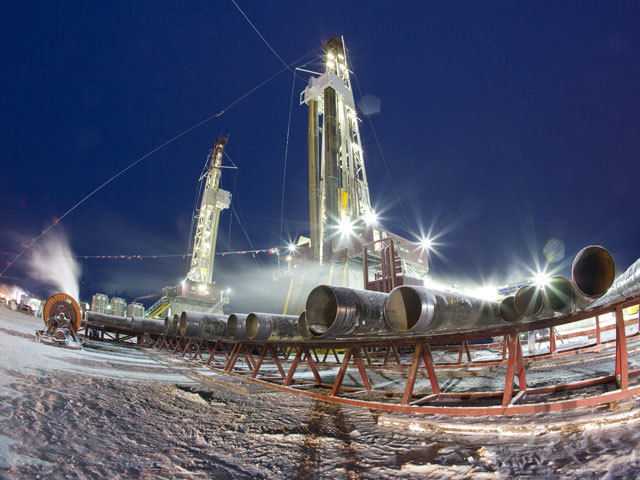
OPEC is resisting pressure to cut oil production while demand slumps as it tests how low prices must go to make US shale oil unprofitable. As producers become more efficient, that floor is sinking.
The Organization of Petroleum Exporting Countries boosted output by the most in 13 months in September, even as crude plunged into a bear market and demand growth weakens to a five- year low, according to the International Energy Agency. Saudi Arabia and Kuwait, the largest and third-largest members of OPEC, indicated the price slump doesn’t warrant immediate production cuts, the IEA said.
While OPEC acted as a “swing producer” over the past decade, responding to surpluses by cutting output, it’s now letting oil slide to see if North American production can withstand lower prices, said Antoine Halff, head of the IEA’s oil industry and markets division. So far drillers are showing no signs of cracking, with the US government forecasting record shale output in November, helping boost the nation’s crude supply to the highest level since 1986.
“This is a new situation and will likely elicit a new response from OPEC,” Halff said by phone from Paris yesterday. “We’re more likely to see OPEC let market forces play out and let the higher-cost production be the first one to cut.”
Brent crude, a benchmark for more than half the world’s oil, was little changed today after falling 4.3% to $85.04 a barrel yesterday, the lowest close since Nov. 23, 2010 on the ICE Futures Europe exchange in London. Brent has dropped more than 20% from its June peak, meeting a common definition of a bear market. West Texas Intermediate crude on the New York Mercantile Exchange sank 4.6% to $81.84, a two-year low.
Saudi Arabia has “appeared determined to defend its market share” in Asia, even at the expense of lower prices, the IEA said in a report yesterday. Kuwait’s oil minister said there may be “no room” to restore prices by trimming supply. Saudi Arabia, Iraq and Iran are offering the biggest discounts to crude buyers in Asia since at least 2009, amid speculation they are seeking to maintain market share.
“It makes perfect sense for Saudi Arabia to let the price drift down,” said Jamie Webster, an analyst in Washington at IHS Inc. “There’s a lot of discussion on what is the break-even price for shale, and whatever you believe, the reality is there’s no clear consensus. It gives the Saudis the opportunity to test” that level, he said.
Iran, OPEC’s fifth biggest supplier, isn’t concerned about the drop in prices, which will pass, Roknoddin Javadi, deputy oil minister and managing director of National Iranian Oil Co., was quoted as saying by Mehr, the state-run news agency.
About 2.6 million barrels of daily production, or 2.8 percent of global output, requires an oil price of $80 a barrel or more to be profitable, the IEA said, with only about 4 percent of US shale output needing prices above that level. Canadian synthetic oil projects are the most dependent on prices remaining above $80.
Horizontal drilling and hydraulic fracturing in hydrocarbon-rich underground shale layers has helped US oil production grow 65 percent in the past five years to the highest level since 1986. That’s reduced crude imports by more than 3.1 million barrels a day since peaking in 2005.
Production per well was projected to increase in fields in North Dakota, Texas and Colorado, the Energy Information Administration said yesterday. Companies are getting more oil per dollar spent drilling, driving costs down as much as $30 a barrel since 2012, Morgan Stanley analyst Adam Longson said in a report Oct. 13.
“Prices aren’t low enough to put these projects at risk,” Matthew Jurecky, head of oil and gas research for the London- based research company GlobalData Ltd., said by e-mail yesterday from New York. “The profit margin on most commercial unconventional oil plays will support prices as low as $50, many below that even.”
US shale producers could keep pumping oil economically even if Brent dropped to $60 a barrel, Bjornar Tonhaugen, an analyst with Oslo-based Rystad Energy, said in an e-mailed report yesterday. Brent would need to remain at $50 a barrel for 12 months before North American shale output drops 500,000 barrels a day, he said. Morgan Stanley said Eagle Ford break- even costs range from $30 to $60 a barrel.
“We continue to be impressed by how much operators are improving their operations,” R.T. Dukes, an upstream analyst for Wood Mackenzie Ltd. in Houston, said yesterday by phone. “There’s enough out there that significant development would continue even at $75 or $80.”
Global oil consumption will expand by about 650,000 barrels a day this year to 92.7 million, the lowest growth since 2009 and about half the increase projected in June, the IEA said. OPEC boosted production in September, pumping 30.47 million barrels a day, the most since August 2013, the group said Oct. 10 in its latest monthly oil market report. Its next meeting is scheduled for Nov. 27 in Vienna.
Saudi Arabia, which pumped almost one-third of the group’s output last month, won’t alter its supplies much between now and the end of the year, a person familiar with its policy said on Oct. 3.
“They’ve not come out and said ‘we will do what it takes to balance the market’,” said Mike Wittner, head of oil market research at Societe Generale SA in New York. “Right now the economy is weak, and demand is weak in Europe and China. The market wants to see something fairly dramatic.”
Recommended for you
